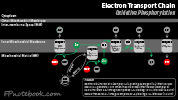Glucose Metabolism, Glycolysis, Embden-Meyerhoff Pathway, Gluconeogenesis, Blood Sugar Regulation, Citric Acid Cycle, Krebs Cycle, Kreb Cycle, Tricarboxylic Acid Cycle, TCA Cycle, Carbohydrate Metabolism, Hexose Monophosphate Shunt, HMP Shunt, Pentose Shunt, Pentose Phosphate Pathway, Phosphogluconate Oxidative Pathway, Incretin, Carbohydrate, Monosaccharide, Simple Sugar, Disaccharide, Oligosaccharide, Polysaccharide, Glucuronidation, Glycoprotein
- See Also
- Definitions
- Carbohydrates
- Largest class of organic compounds, and contain 3 or more carbons and multiple hydroxyl groups (OH)
- Include starches (Glucose polymers, e.g. glycogen), Disaccharides (e.g. sucrose) and Monosaccharides (e.g. Glucose)
- Most Carbohydrates also contain either an aldehyde group (as with Glucose) or keto group (as with fructose)
- Functions include energy sources, cell signaling, structural molecules and synthesis of Amino Acid, Nucleic Acid, lipid
- Glycolysis (Embden-Meyerhoff Pathway, Glycolytic Pathway)
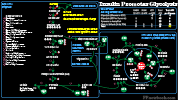
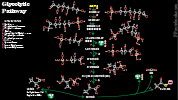
- Catabolic pathway to breakdown Carbohydrates (Glucose, fructose) into pyruvate, without need for oxygen
- Represents only a small part of the overall energy generation from Carbohydrates (2 net ATP and 1 NADH)
- Pyruvate may then be converted to acetyl-CoA (or, when oxygen is unavailable to Lactic Acid)
- Acetyl CoA enters TCA Cycle for energy generation (or is used to form Triglycerides)
- Triggered by Insulin, which lowers Glucose via both Glycolysis as well as increasing glycogen stores
- Glycolysis occurs in the cytoplasm of cells throughout the body
-
Acetyl Coenzyme A (Acetyl CoA)
- Synthesized from Coenzyme A and acetic acid
- Acetyl CoA is substrate in the biosynthesis of Fatty Acids, sterols and Amino Acids
- Serves as entry point of Citric Acid Cycle
- Feeds it substrate from Glucose (and other Carbohydrate), Amino Acid and Fatty Acid catabolism
- Citric Acid Cycle (Krebs Cycle, Tricarboxylic Acid Cycle, TCA Cycle)

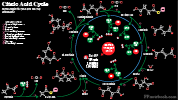
- Universal pathway seen across multicellular organisms, taking place in the mitochondria of humans
- Citric Acid Cycle does not occur in Red Blood Cells (which lack mitochondria)
- Generates energy from Acetyl CoA (3 NADH, 1 FADH, 1 GTP) derived primarily from Glucose
- Intermediate steps include oxaloacetate, isocitrate, a-Ketoglutarate, succinyl-CoA, Succinate, fumarate, malate
- Kreb Cycle intermediates also lead to other pathways (e.g. succinyl-CoA to heme synthesis pathways)
- With decreased Energy Intake or increased Energy Expenditure, Glucose reserves (e.g. glycogen) are exhausted
- In early starvation, Fatty Acids are catabolized to acetyl CoA (and Glycerol), fueling the Krebs Cycle
- With longer starvation, Amino Acids are catabolized to enter the Krebs Cycle
- Gluconeogenesis
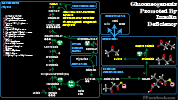
- Pathway forms Glucose from 3- or 4-carbon noncarbohydrate precursors (e.g. pyruvate, Amino Acids and Glycerol)
- Process takes place in the liver (and Kidney) and is triggered when Insulin levels are low and in starvation states
- The same triggers for Gluconeogenesis also trigger Lipolysis and Ketogenesis
- 3 enzymes limit Gluconeogenesis to liver (Pyruvate carboxylase, Fructose Diphosphatase, Glucose 6-Phosphatase)
- Hexose Monophosphate Shunt (HMP Shunt, Pentose Shunt, Pentose Phosphate Path, Phosphogluconate Oxidative Pathway)
- Glucose-6P is converted to a 5 carbon sugar, Ribose-5P, over several steps that generate two NADPH and CO2
- NADPH is a Reducing Agent (donating H+) in cellular reactions
- Active throughout the body (including in RBCs, which lack mitochondria)
- Ribose-5P is used to generate Nucleic Acids (DNA, RNA)
- When Ribose-5P is in excess, it may be converted to Glyceradehyde-3P (Glycolytic Pathway)
- Glucuronidation
- Glucuronic Acid (UDP-Glucuronate) is a water soluble derivative of Glucose, synthesized in the liver
- In Glucuronidation, Glucuronic acid is conjugated to other molecules to facilitate their excretion in urine and bile
- Glucuronidation inactivates and detoxifies various substances (e.g. Bilirubin, bile acids, sex Hormones, Corticosteroids)
- Physiology
- Carbohydrates
-
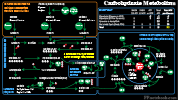
- Carbohydrates, when burned as energy, generate 4 Kcals/g, and are exhausted in first day of starvation
- Starches and Disaccharides are cleaved into Monosaccharides before intestinal absorption
- Mediated by Stomach acid and Salivary, intestinal and Pancreatic Enzymes (see below)
- Amylase (Saliva, Pancreas) cleaves starches into Glucose and Disaccharides in the Gastrointestinal Tract
- Intestinal wall enzymes cleave Disaccharides: sucrose (sucrase), lactose (lactase) and maltose (maltase)
- Simple Sugars (Glucose, fructose and galactose) are absorbed across the small intestinal epithelial cell walls
- Polysaccharides
- Combination of more than 10 Monosaccharides (Simple Sugars)
- Branched structures (glycogen, amylopectin) allow for efficient building and breakdown of chains
- Multiple end points allows for multiple reactions to occur in parallel, simultaneously
- Starches (Glucose polymers, cleaved by amylase into maltose)
- Structural Polysaccharides
- Cellulose
- Chitin
- Forms the cell wall of fungi, and the exoskeleton of arthropods
- Pectin
- Alpha1,4 linked galacturonic acid polymer found in non-woody cell plant cell walls
- Extracted from citrus fruits, and used as a gelling agent in cooking (e.g. jams)
- Oligosaccharides
- Combination of 3 to 10 Monosaccharides (Simple Sugars)
- Function in cell signaling, cell adhesion and cell recognition
- Dietary Oligosaccharides
- Fructo-Oligosaccharides (chain of fructose molecules, e.g. found in vegetables)
- Galacto-Oligosaccharides (chain of galactose molecules, e.g. found in milk)
- Often a part of glycans, Glycoproteins (linked to Amino Acids) or Glycolipids (linked to lipids)
- See Glycolipids
- N-Linked Oligosaccharides (attached to Asparagine)
- O-Linked Oligosaccharides (linked to Threonine or Serine)
- Glycoprotein
- Synthesis
- Fructose 6-P joins Glutamine to form Glucosamine 6-P (amino sugar)
- Glucosamine 6-P may be transformed into other amino sugars
- Amino sugars are joined with simple Carbohydrates
- Functions
- Glycolipid components
- N-Acetyl Galactosamine (8 carbon amino sugar)
- Sialic Acids (11 carbon amino sugars)
- Cell membrane components
- Antigenic sites (including ABO Blood Type)
- Receptor sites
- Blood Proteins
- Some Hormones (e.g. TSH, FSH)
- Immunoglobulins
- Blood ClottingProteins
- Proteoglycans
- Contain glycosaminoglycans or mucopolysaccharides (predominant Carbohydrate components)
- Glycosaminoglycans are viscous or mucoid (high water consistency)
- Examples include hyaluronic acid, chondroitan sulfate, Heparin
- Glycolipid components
- Synthesis
- Disaccharides
- Monosaccharides (Simple Sugars)
- Monosaccharides are Carbohydrates that cannot be hydrolyzed (lysed with water) to simpler sugars
- Trioses have 3 carbons
- Tetroses have 4 carbons
- Pentoses have 5 carbons
- Hexoses have 6 carbons
- Hexose Examples
- Glucose
- Glucose is the primary cellular fuel stored in glycogen or metabolized via Glycolysis
- Blood Glucose increases via intestinal absorption, gluoconeogenesis or glycogenolysis
- Fructose
- Absorbed from the intestinal tract after sucrose is cleaved into Glucose and fructose
- Fructose may be metabolized to a 3 carbon sugar that enters the Glycolysis pathway
- Also used to generate lipids (via fructose 1P, glyceraldehyde 3P, dihydroxyacetone P)
- Galactose
- Absorbed from the intestinal tract after lactose is cleaved into Glucose and galactose
- Galactose may be converted to Glucose-UDP and then metabolized or stored as Glucose
- Important role in glycans, Glycoproteins (linked to Amino Acids) or Glycolipids (linked to lipids)
- Glucose
- Monosaccharides are Carbohydrates that cannot be hydrolyzed (lysed with water) to simpler sugars
- Physiology
- Carbohydrate Metabolism
- See Gastrointestinal Metabolism
- Images
- Glycogen Storage
- Excess Blood Glucose is stored in glycogen
- Glucose is converted to Glucose 6P, Glucose 1P and then UDP Glucose
- UDP Glucose is then linked into amylose (non-branched) and finally glycogen (branched)
- Glycogen breakdown occurs when Blood Glucose levels are falling
- Glycogen is branched (1-6 bond) and requires a debranching enzyme during breakdown
- Phosphorylase cleaves off Glucose from non-branched Glucose chains into Glucose-1P
- Phosphorylase stops cleaving Glucose as it approaches 1-6 branches
- Debranching must occur next before Phosphorylase continues on the current chain
- In Muscle, Glucose-1P (and Glucose-6P) is trapped within the cell and utilized for Muscle energy
- In liver, Glucose-1P is converted to Glucose-6P, then via Glucose 6-Phosphatase to Glucose
- Glucose exits the liver cells, and is used systemically by cells for energy
- Other methods of direct glycogen breakdown
- Glycogen breakdown is stimulated by Epinephrine (Muscle Cells) and Glucagon (liver cells)
- Both Epinephrine and Glucagon act at the cell membrane to stimulate adenylate cyclase
- Triggers cyclic AMP which in turn activates phosphorylase and glycogen breakdown
- Excess Blood Glucose is stored in glycogen
-
Blood Glucose
- Released from hepatic stores between meals
- Derived from ingested Carbohydrates
- Postprandial Glucose >20 fold over hepatic release
-
Insulin
- See Insulin
-
General
- Insulin is an anabolic Hormone that is released in the fed state
- Involves triggers mechanisms to move Blood Glucose into storage
- Insulin is produced by pancreatic beta cells
- Insulin release is stimulated by Blood Glucose
- Insulin response to Glucose is linear
- Overall Insulin effects
- Promotes Glucose uptake by liver and Muscle and for storage as glycogen
- Promotes cellular uptake of Amino Acids and Protein synthesis
- Promotes hepatic synthesis of Fatty Acids, VLDL transport to adipose for Triglyceride storage
- Promotes Glycolysis for energy utilization
- Suppresses Gluconeogenesis
- Insulin is an anabolic Hormone that is released in the fed state
- Phase 1 Insulin Release
- Duration: 10 minutes
- Suppresses hepatic Glucose release
- Phase 2 Insulin Release
- Duration: 2 hours
- Controls mealtime Carbohydrates
-
Basal insulin Release
- Low continuous Insulin level
- Covers metabolic needs between meals
-
Glucagon
- See Glucagon
- Endogenous polypeptide Hormone secreted by pancreatic alpha cells
- Opposite effect of Insulin
- While Insulin lowers Serum Glucose (glycogen storage, Glycolysis), Glucagon increases Serum Glucose
- However, both Insulin and Glucagon increase Amino Acid uptake from the liver
- Hypoglycemia effect (primary)
- Inhibitors of Glucagon release
- Hyperglycemia
- Inhibits pancreatic secretion of Glucagon
- GLP1 (Incretin)
- Secreted by Small Bowel
- Stimulates pancreatic beta cells and inhibits Glucagon
- See Incretin Mimetics (used in Type 2 Diabetes Mellitus)
- Hyperglycemia
-
Amino Acid Excess Effect
- Increases pancreatic secretion of Glucagon
- Glucagon stimulates liver uptake of Amino Acids
- Both Insulin and Glucagon increase liver uptake of Amino Acids
-
Glucagon has similar activity to Epinephrine (in terms of Glucose Metabolism)
- Most active in liver (contrast with Epinephrine which is most active in Muscle)
- Both Epinephrine and Glucagon act at the cell membrane to stimulate adenylate cyclase
- Triggers cyclic AMP which in turn activates phosphorylase and glycogen breakdown
- Glucagon also acts at Catecholamine-independent receptors on cardiac cells
- Increases intracellular Calcium in cardiac cells
- Increases myocardial contractions
-
Epinephrine
- See Epinephrine
-
Epinephrine has alpha-adrenergic effects (esp. alpha-2) specific to metabolism
- Increases Serum Glucose (Gluconeogenesis, Glycogenolysis)
- Increases Fatty Acids (Fat cell lipolysis of Triglycerides)
- Similar activity to Glucagon (in terms of Glucose Metabolism)
- Both Epinephrine and Glucagon act at the cell membrane to stimulate adenylate cyclase
- Triggers cyclic AMP which in turn activates phosphorylase and glycogen breakdown
- Most of Epinephrine's primary effects are cardiopulmonary
- Alpha Adrenergic Agonist Effects
- Vasoconstriction (increased Systemic Vascular Resistance and Blood Pressure)
- Increases Vital Organ Perfusion (myocardial and cerebral perfusion)
- Decreases Non-Vital Organ Perfusion
- Decreases splanchnic and intestinal perfusion
- Decreases renal and skin perfusion
- Beta Adrenergic Agonist effects (Under 0.3 ug/kg/min)
- Increases myocardial contractility and Heart Rate
- Relaxes Bronchial Smooth Muscle (bronchodilation)
- Alpha Adrenergic Agonist Effects
-
Growth Hormone
- See Growth Hormone
- Polypeptide produced in the acidophil cells of the anterior pituitary
-
Hypothalamus controls release when triggered by Hypoglycemia, decreased Amino Acids
- Growth Hormone Releasing Hormone (GHRH) stimulates release
- Somatostatin inhibits release
- Biochemistry
- Liver converts Growth Hormone to Insulin-like growth factor (IGF-1) and stimulates other growth factors
- Growth Hormone is a precursor to Testosterone
- Positive Function (stimulates or promotes the following activities)
- Bone and cartilage growth
- Protein synthesis
- Promotes Fatty Acid use as fuel instead of Glucose
- Lipid catabolism to Fatty Acids (for energy source)
- Hyperglycemia (from decreased cell utilization of Glucose) resulting in an increase of glycogen stores
-
Cortisol
- See Cortisol
- Cortisol is synthesized in the Adrenal Cortex, derived from Cholesterol (See Cortisol Synthesis_
- Cortisol secretion is stimulated by Adrenocorticotropic Hormone (ACTH) in response to stress (See Pituitary Gland)
-
Cortisol functionality
- Mobilizes available energy sources (Glucose, fats, Amino Acids)
- Increases Serum Glucose by stimulating liver Gluconeogenesis and glycogenolysis
- Increases serum Fatty Acids by promoting lipolysis of adipose Triglyceride stores
- Increases blood Amino Acids by breaking down Proteins (outside liver)
- Antiinflammatory activity
- Inhibit Histamine release
- Inhibit Lymphocyte production
- Stabilize MacrophageLysosomes
- Increases gastric acid production
- Mobilizes available energy sources (Glucose, fats, Amino Acids)
- Incretin
- Pathophysiology
- Lactic Acid
- See Lactic Acid
-
Lactic Acid is generated when oxygen is unavailable to allow for Krebs Cycle related Oxidative Phosphorylation
- Occurs with both skeletal Muscle anaerobic metabolism as well as other physiologic stress (e.g. Sepsis)
- Lactic Acid may also be generated during aerobic conditions
- Glycolysis generates 7 net ATP/Glucose (compared with 25 for Kreb Cycle) and does not require oxygen
- However, Glycolysis does use NAD+ (for glyceraldehyde 3-P to 1,3P2-glycerate)

- NAD+ is typically replenished in the Krebs Cycle related Oxidative Phosphorylation
- When oxygen is unavailable, pyruvate is metabolized to Lactic Acid, regenerating NAD+
-
Lactic Acid conversion back to Glucose (Gluconeogenesis) requires several additional steps

- Muscle Cells release generated Lactic Acid
- Lactate may be directly utilized by the Heart (up to 60% of energy demands) and brain (up to 25% of energy demands)
- Lactic Acid is transported via systemic circulation to liver and Kidney
- Liver (70-75%) and Kidney (25-30%) cells perform lactate metabolism (Gluconeogenesis)
- Three Enzymes required for Gluconeogenesis from Lactic Acid are only in cells of the liver and Kidney
- Pyruvate carboxylase
- Fructose Diphosphatase
- Glucose 6-Phosphatase
- Pathophysiology
- Insulin
-
Insulin excess
- See Hypoglcemia
- See Insulin Shock (Insulin Overdose, Insulin Reaction)
-
Insulin at low levels or deficiency
- Causes
- Low Insulin due to Diabetes Mellitus
- In Type I Diabetes, Insulin deficiency is key
- In Type II Diabetes, Insulin Resistance is key initially, but later Insulin deficiency results
- Low Insulin as a normal physiologic response to Hypoglycemia
- Low Insulin due to Diabetes Mellitus
- Low Insulin effects
- Gluconeogenesis and Glycogenolysis results in Hyperglycemia
- Lipolysis (Triglyceride breakdown to Fatty Acids)
- Further lysed into acetyl coA to be utilized in the Kreb Cycle (TCA Cycle, Citric Acid Cycle)
- Other Fatty Acids are diverted to Ketogenesis (Ketone formation)
- Fatty Acids also form excess Cholesterol, Triglycerides within VLDL with increasing atherosclerosis
- Causes
- Pathophysiology
- Type I Diabetes
- See Type I Diabetes Mellitus
- See Maturity Onset Diabetes of the Young
- Deficiency of Insulin, with multiple underlying mechanisms
- Type 1A
- Environmental and genetic factors
- HLA-DR4 association
- Cell mediated pancreatic beta cell destruction
- Type 1B (uncommon)
- Primary Autoimmune Condition
- Associated with other Autoimmune Conditions
- HLA-DR3 association
- Incidence highest in 30-50 year olds
- Secondary Diabetes Mellitus
- Pathophysiology
- Type II Diabetes Mellitus
- See Type II Diabetes Mellitus
- Loss of Glucose sensitivity (see above)
- Insulin production by beta cell
- Impaired Incretin action
- Incretins manage postprandial Glucose levels
- Incretin released from GI Tract following meals
- Endogenous Incretin effects
- Progressive Incretin reduced activity
- Glucagon-Like Peptide 1 (GLP-1) activity decreases
- Incretins manage postprandial Glucose levels
- Medications
- Increase Insulin sensitivity
- Stimulate Insulin release from beta cells
- Meglitinides (act on phase 1 release)
- Sulfonylureas (act on phase 2 release)
- Replace Insulin
- See Insulin
- Increase Incretin levels (GLP-1)
- References
- Goldberg (2014) Clinical Physiology, Medmasters, Miami, p. 120-46
- Goldberg (2001) Clinical Biochemistry, Medmasters, Miami, p. 13-16
- Guyton and Hall (2006) Medical Physiology, 7th Ed, Elsevier Saunders, Philadelphia, p. 829-58
